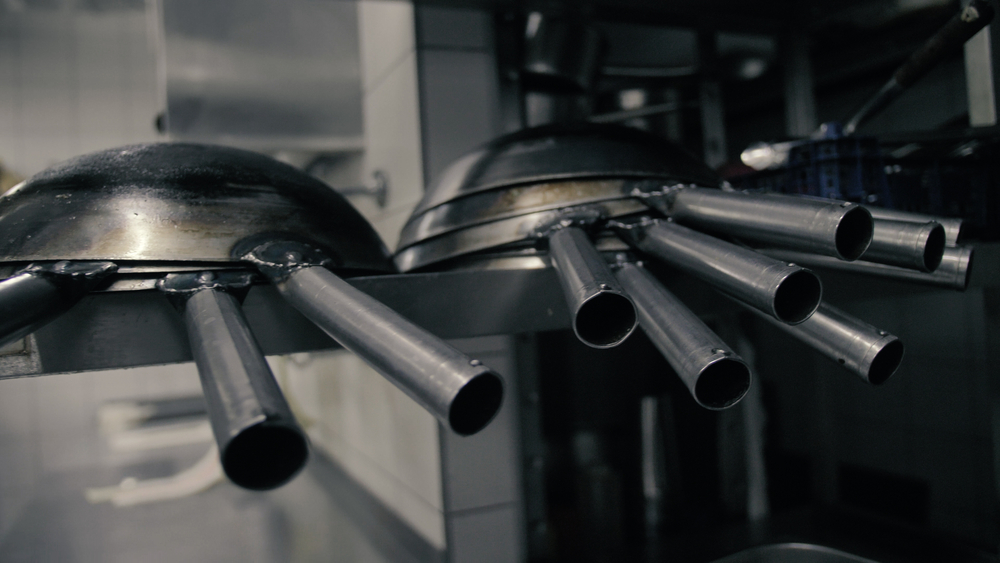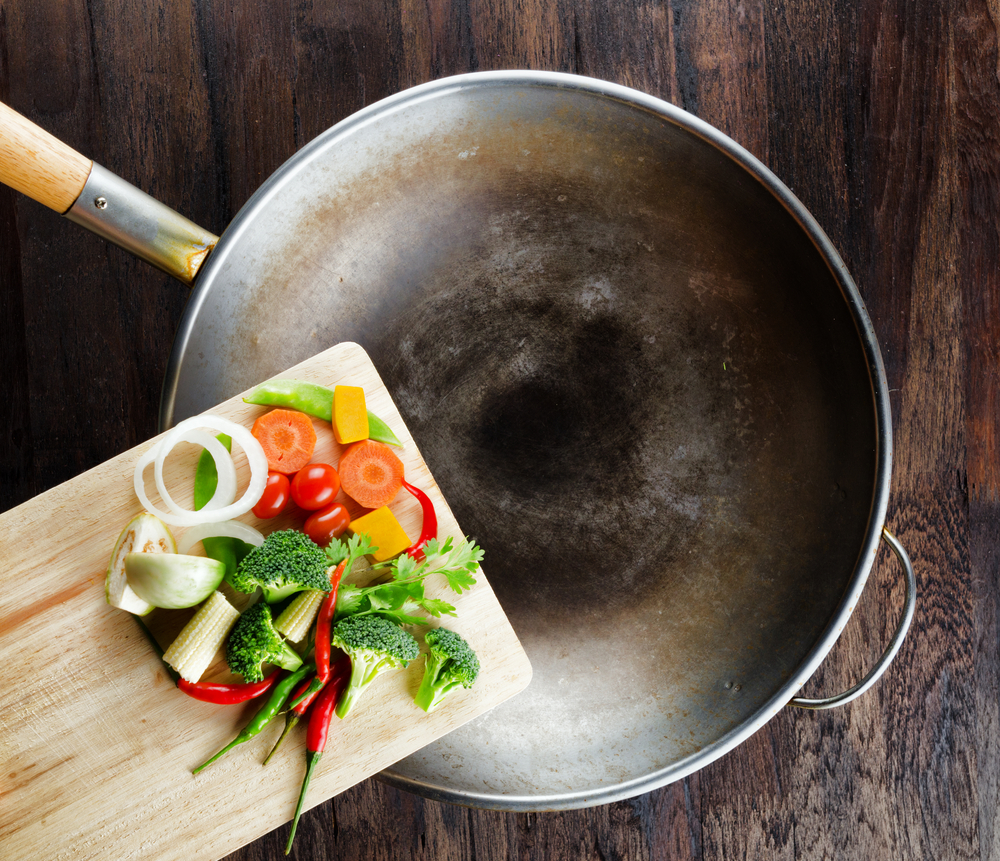Do you know how to clean a wok? We don’t mean just giving it a little wash. Instead, we mean a real clean, so everything is hygienic the next time you use it.
But there’s a problem.
The problem is the seasoning process. Your carbon steel wok, or even a stainless steel wok, needs to be seasoned. That is what then acts as a non-stick surface, and it makes cooking with your wok a lot easier.
However, scrubbing your wok vigorously may make it far less effective for cooking. You will get burnt food, and the general wok experience will not be as good.
But that aside, let’s get more into how to clean a wok properly.
How to Clean a Carbon Steel Wok Properly
Step 1: The Basic Cleaning
When trying to clean a carbon steel wok, you need to be gentle and patient. Remember, you don’t want to remove that patina that is developing on your new wok, which makes carbon steel woks so good. Washing the work is easy, but it’s not as straightforward as you may think. Instead, woks have a particular way of being cleaned.
Now, many people argue you should not even use dish soap to clean a carbon steel wok after you have successfully seasoned it. While that is a common thought, it’s not something that is set in stone. If you feel unsure about just rinsing things, then a little dish soap and a soft sponge over your wok won’t cause a problem.
Step 2: Soaking is Key
How do you clean a burnt wok? When trying to get a burnt wok clean, soaking it will be the key to removing that stuck-on food. Those food particles will be tough to get off, and while some people argue you should only use water, using some hot soapy water, without the scrubbing part, can also work well.
The most important part here is to make sure that you have warm water. You may even want to put the wok on low heat for five minutes, as the heat will make it easier to get those burnt-on pieces of food off the wok’s surface.
Be aware that the soaking process can take longer. This depends on what you were cooking and also if you have not been caring for your wok properly or not re-seasoning it with vegetable oil regularly. If that is the case, check after ten minutes using a wok brush or wok spatula to see if those pieces of food have become dislodged.
If not, continue soaking the wok. The residue will eventually come off, even though it may take longer than expected.
Step 3: The Actual Washing
When most of the food has come off, it’s time for the actual washing.
People argue that you should only use warm water and a soft sponge. You are going to wipe and gently scrub your carbon steel wok in order to get it clean. However, avoid scrubbing your carbon steel wok vigorously. Never even use a stainless steel scrubber, thinking you need to get every mark off. That’s not the case.
It would help if you rinsed the wok well before you started to dry it. Rinse it with hot water, and then move on to the next step.
Step 4: The Drying Process
If you thought you would pick up some paper towel and wipe the inside of carbon steel pans dry, you would be wrong.
Instead, after emptying out the water, you need to place your wok on low heat, allowing your cookware to dry thoroughly. Don’t even think about using medium heat at this point. Low heat is perfectly fine for drying your wok.
Step 5: Preparing for Storage

But now we move onto something vital, yet it’s a step that is often overlooked, and that’s the correct storage of your wok.
Now, some will argue you should re-season a wok after every use, and that’s pretty true.
For this, you need to make sure it is completely dry before you do the seasoning.
Next, add a small amount of oil to your wok and put the cookware on the stove over high heat. You want to heat that oil and coat the wok.
After that, remove the pan from the stove and let it cool. Use a paper towel to wipe away the excess oil. Allow the wok to air dry completely, and then put it away for storage.
Essential Tips for Cleaning Your Wok
Cleaning your carbon steel wok should never be difficult, but it’s not something you can just throw in the dishwasher. Here are some additional tips that will make life easier for you when it comes to caring for cast iron or carbon steel woks.
Don’t Bother With a Good Scrub
The first tip is to wash the wok and don’t worry about scrubbing it. You are used to giving your frying pan a good scrub to get it spotless, but a seasoned wok is a completely different thing. It’s designed to be easier to clean, thanks to how the oil you use for cooking becomes part of the seasoning process.
Make Sure It Is Very Dry
You need to prevent rusting wherever possible, and that means making sure the pan is completely dry before putting it away. When not cared for correctly, woks are prone to developing rust spots easily.
Inspect your cookware for any signs of rust to remove them immediately.
Don’t Forget to Soak Your Wok in Water
Never skip the step where you soak the pan to get it clean. Now, the entire surface doesn’t have to be submerged in water. However, the main cooking area needs to be covered to ensure those remnants are removed.
Also, don’t use high temperatures when removing burnt food from the wok’s cooking surface. A lower heat setting works well at this stage of trying to get your wok clean, so stick with that.
Always Add a Thin Layer of Oil
You must always add that thin layer of oil for your wok to remain properly seasoned. That way, it’s ready for your next attempt at cooking the perfect stir fry. Additionally, keeping your wok well-seasoned will help prevent rust and stains.
You Can Use Almost Any Oil
If you have vegetable oil, then use it. If you have canola oil, then that’s also fine. The most important thing here is to make sure your cast iron or carbon steel wok is lightly oiled to complete the seasoning process.
Always Remove Any Excess Oil
Never leave the oil in your seasoned wok. Always use paper towels to remove any excess oil before storing your cookware. You don’t want that old stagnant oil to be sitting on the pan the next time you cook delicious recipes with your wok.
Cleaning Woks the Right Way
We hope you found this step-by-step guide on how to clean a carbon steel wok helpful. There are just a few steps for you to go through to achieve the desired results.
Also, just remember that cleaning a wok is different from cleaning a normal frying pan. You don’t want your work to be sparkling clean with all residue of what you just cooked removed. That’s part of seasoning your wok and ensuring that its surface remains non-stick.
An important thing to remember is woks can develop rust quite quickly. You can prevent rust by ensuring you’re not using abrasive cleaning materials on your wok and by keeping it dry. Seasoning your wok properly also prevents rust spots from forming.
Have you tried cleaning a wok? How was it? Tell us about your experience in the comments. And if you have your own cleaning tips to share, we’d love to hear about them too!

